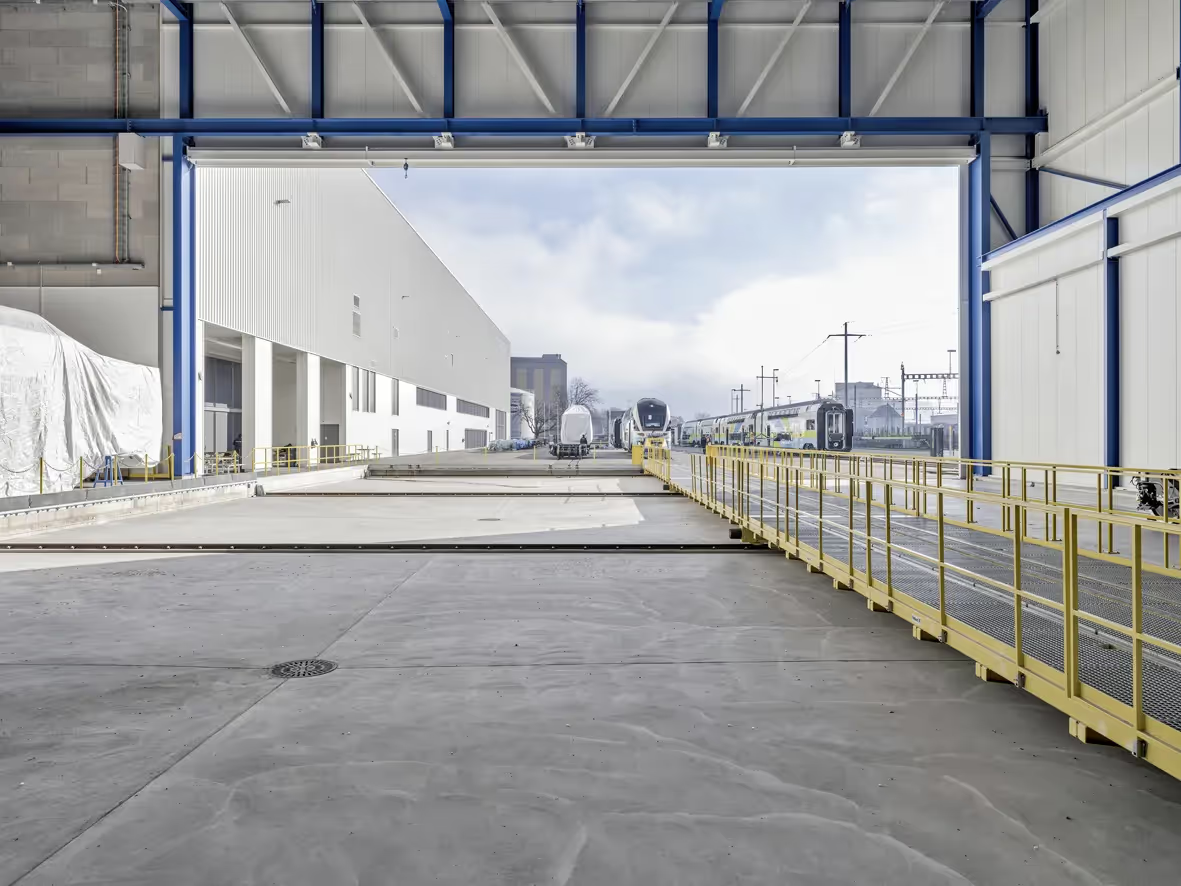LOCATION / HISTORY
The complex, comprising the new office and production buildings of railway vehicle manufacturer Stadler Rheintal AG, is located directly north of the St. Margrethen train station. The Centre is located on the other side of the extensive tracks. The level area between the railroad facilities and the Old Rhine is known as the Altfeld site. The site of the new building was first developed in the 1950s and served for a long time as a warehouse for local company Holzindustrie AG (HIAG).
From the early 1990s onwards, the Altfeld site was an industrial wasteland used for various purposes on a temporary basis. From 2006 to 2011, the land owner HIAG developed the “europuls” project. They envisaged developing a business park for retail and residential use, but it was not completed due to the market situation. In 2017, HIAG concluded a building rights agreement with Stadler Rail for the site. Stadler Rail
expressed its intention to relocate as much as possible from a previous location in the neighbouring town of Altenrhein and instead move into a new building in St. Margrethen. The municipal authorities subsequently re-zoned the Altfeld site for which a new core zone K5 had been created due to “europuls”. Imposing a partial road plan, it also ensured that the area was well connected to the train station via a footbridge for pedestrians and cyclists.
HRS Real Estate AG was able to complete the new competence centre for double-decker trains as the project developerand total contractor with full cost, quality, and schedule guarantees. Development and planning were carried out according to the design-to-cost principle in order to guarantee a tailor-made project with cost certainty.
DESIGN / ARCHITECTURE
The compact building complex, based on a strict orthogonal grid, runs parallel to the train tracks from west to east. It offers sufficient space for around 1400 employees. The production and storage areas are optimally coordinated over an area of around 35,000 square meters. The facility also offers offices for around 450 employees over approximately 5000 square meters. These employees perform development work forthe vehicles at the St. Margrethen site and support Stadler throughout the company in the fields of calculations and approvals.
The various functional areas form a sequence of spatial layers from north to south. The main and delivery access points are on the southern edge of the site via the Altfeldstrasse. Here there is also a rail connection to the small shunting yard in the south-east corner of the plot. Deliveries take place via an internal road around the building complex. Employee parking spaces are also incorporated into the site along this road.
On the northern edge, the administrative building on the highly frequented Neudorfstrasse forms a striking entrance. The elongated, cube-shaped, closed six-storysolitary building is the tallest in the area at slightly less than 25 meters. An enclosed footbridge connects it on the fourth and fifth floors with the rest of the building, which is made up of a closely interwoven conglomerate of several structures. The
administrative building has a two-story exposed concrete base with parking garages. The lower level is accessible via the internal access bypass and the upper next to the main entrance from Neudorfstrasse which lies somewhat higher. Surrounding band windows divide the four office floors. The blind portions of the facade over the entire complex are clad with white powder-coated trapezoidal sheet metal. The vertical ribbing of the building cover together with the blue lettering of the company name are distinctive features that characterise the entire building complex.
The four-story social wing can be accessed from the administration building via the footbridge. This narrow building contains generous cloakroom facilities for employees on the two lowest floors. The fourth floor houses the staff restaurant and cafeteria. Both have a covered outdoor space on the respective adjoining front facades which, with a loggia-like design, provides unobstructed views of the surroundings. The other spaces in this wing are primarily used as storage and production rooms.
To the west of the social wing, the cover of the building is arranged under a projecting canopy. To the south of it are the storage and setup wings and the assembly, final assembly, and commissioning areas. East of these halls is a covered shunting zone. This leads on into the halls for surfacetechnology and body construction. The height of these functional units, which are up to around 100 meters long, varies between around 15 and 20 meters. The flat roofs are equipped with skylights, and steel structures allow large spans of up to 40 meters. The carriage bodies can be moved efficiently with several overhead cranes.
For fire regulation reasons, fire extinguishing facilities have been installed at regular intervals across the entire area. Instead of installing a cold-water pipe and a parallel pipe system for firefighting water, all hook-ups were connected to a single ring line. Due to the length, a lot of water collects in the pipes. Anyone who draws water from a tap contributes to the daily flushing out of the pipes, thus ensuring the hygiene of the entire system.
ENERGY
A 1.1 MW photovoltaic system was installed on the roofs of the new complex. The electricity is consumed directly in the factory buildings. The plant was financed by the Genossenschaft Solar St. Gallen Cooperative. It supplies Stadler with around one million kilowatt hours per year for its own consumption. It is expected that photovoltaics will be able to cover around a quarter of the electricity consumption of the Stadler Rail site in St. Margrethen. In order to ensure rainwater retention on the roof surfaces, a special green roof mounting system was used for the solar modules. This allows biodiversity to develop on the roof.
In view of the large dimensions of the building, a grouped layout of hot water pipes from decentralised water heaters was chosen. These are connected to air-to-water heat pumps that use the waste heat from the factory.




























